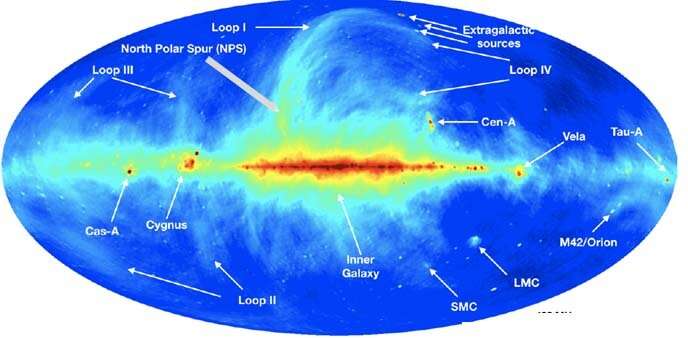An image of the Milky Way as seen at radio wavelengths and showing the prominent North Polar Spur, the larger Loop 1, and other features. Astronomers have measured the distance to the Spur from new Gaia satellite distances of molecular clouds and find that it is about five hundred light-years, much closer than proposed by some models that associated it with galactic nucleus and the Fermi bubbles. Credit: Haslam, C.G.T. et al., Astron. Astrophys. Suppl. Ser. 1982
One of the largest structures in the Milky Way galaxy, the North Polar Spur, was discovered at radio and X-ray wavelengths. The Spur is a giant ridge of bright emission that rises roughly perpendicularly out of the plane of the galaxy starting roughly in the constellation of Sagittarius and then curves upward, stretching across the sky for over thirty degrees (the size of sixty full-moons) where it appears to join other bright filamentary features. The emitted radiation is highly polarized, indicative of its being produced by ionized gas in the presence of strong magnetic fields. Depending on how far away the Spur is from us, its length estimates range from hundreds to thousands of light-years.
One major theory for the Spur argues that it is a local structure produced by a supernova remnant and is perhaps only a few hundred light-years away. Other studies using the absorption of starlight seen through the Spur suggest it is more like a thousand light-years away. Using gas kinematic observations and related datasets, a different group argues that it is more like six-to-ten thousand light-years away. Because the general shape of the loop is reminiscent of the giant Fermi bubbles discovered emanating from the galactic center region, other astronomers argue that the Spur is actually part of a shock front produced by star formation activity that occurred about fifteen million years ago near the galactic center about twenty-five thousand light-years away.
A robust constraint on the distance of the Spur has implications for our understanding of its origin and structure, but as well for that of other bright extended emission loops, the galactic bubbles, supernova activities in the solar neighborhood, and outflows of material seen coming from nuclei in other galaxies. CfA astronomers Catherine Zucker, Joshua Speagle, and Alyssa Goodman and their colleagues used the recent release of Gaia mission parallax measurements to determine accurate and precise distances to local molecular clouds. By comparing those data with measurements of the interstellar extinction toward the Spur and independent observations of the quantities of gas along different lines-of-sight, they conclude that almost all of the Spur is within a distance of five hundred light-years (a smaller section might be as far as a few thousand light-years). Based on their results, they argue that the Spur is not associated with the Fermi bubbles nor the galactic center, but rather with the closer Scorpius-Centaurus OB association of massive young stars.
More information: Kaustav K Das et al. Constraining the distance to the North Polar Spur with Gaia DR2, Monthly Notices of the Royal Astronomical Society (2020). DOI: 10.1093/mnras/staa2702
Journal information: Monthly Notices of the Royal Astronomical Society
Provided by Harvard-Smithsonian Center for Astrophysics
























